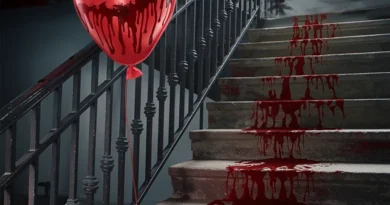Sleep Paralysis: Closest Thing To A Horror Movie In Reality
Every few months, it happens. Right around falling asleep or waking up in the morning, I hear noises and voices next to me. I understand what it is about, as someone already used to it. My wife is going through sleep paralysis, the details of which she will pass on to me after she calms down. A little later, with the morning coffee, I hear her descriptions of ghosts walking her way, monsters on the wall, and other gruesome surprises. So she feels like it’s happening right next to her, but she can’t move or do anything.
My wife does not like horror movies, to say the least, and she would be happy to get rid of this “habit.” Maybe call me crazy, but as someone who watches horror movies in commercial quantities but has trouble finding movies that scare him, I can’t help but – believe it or not – occasionally envy my wife. “Here is finally a chance to be scared and experience the feeling I’m so looking for in horror movies,” I think to myself and sometimes also say aloud (a mistake, because she now thinks I’m crazy). So what is sleep paralysis, why do some people suffer from it, is it dangerous, and which horror movies focus on this phenomenon? The “Horror Academy” will put some order in the mess.
Sleep Paralysis: Like A Nightmare, Only Scarier
Sleep Paralysis includes several possible symptoms, which explain why it is an experience that is anything but pleasant for most people who experience it. This condition usually occurs before falling asleep or immediately after waking up, and it manifests in a very problematic way: the body of the person experiencing the phenomenon remains paralyzed, just as it was in the dream state (REM). In this state, the person is awake, but his dream mechanism is still working to a certain extent, and due to the blockage caused by the nervous system, he cannot move and usually cannot speak, either. Sometimes you experience additional Sleep Paralysis symptoms such as difficulty breathing, trembling in the body, or a feeling of falling.
Even more important in this context is that the person may experience terrifying hallucinations, including encounters with ghosts, monsters, and other scary creatures – sometimes when he is aware that he is awake but cannot move, speak or do anything. Unlike “normal” nightmares, the hallucinations experienced here occur in the place of sleep, usually the bedroom. The person may see creatures approaching him, climbing the walls or ceiling, or even pressing on his chest. Various paintings depicting this phenomenon show monsters and demons sitting or standing on us.
💀 Killer Deals & Scary Recommendations 💀
🎭 Costumes & Accessories
HalloweenCostumes Fun Costumes Entertainment Earth
🛒 Online Shopping
AliExpress Amazon Walmart Etsy
🧛 Collectibles & Horror Brands
Funko Hot Topic Lego Spirit Halloween
🎢 Attractions & Tours
GetYourGuide Tiqets Viator Klook
📖 Blogs & Horror Sites
Bloody Disgusting iHorror Fangoria
🩸 Disclaimer: Some links are affiliate links. The price stays the same – it just helps keep the site alive 👻
What Causes Sleep Paralysis?
The truth is that even today, it is impossible to definitively detemine why does Sleep Paralysis happen, even if there are several risk factors. Sleep Paralysis typically occurs in people wo are at their 20s and 30s, although one may also suffer from it starting in childhood or later in life. The not-so-encouraging statistics show that the probability of experiencing such an event at least once in a lifetime is high and is about 25-50% of the population in the United States, according to the data of the American Health Organization.
One of the basic assumptions accepted today is that the chances of experiencing sleep paralysis increase as a person’s natural mechanism of wakefulness and sleep cycles go wrong. This may be caused by several reasons, including Lack of sleep, Inconsistency in sleep times, pressures and anxieties, medical conditions related to sleep, such as obstructive sleep apnea or Narcolepsy. Side effects of drugs taken, and even common When the nightmare becomes a reality.
Meet The Sleep Paralysis Demon
It is not difficult to understand why sleep paralysis is connected to nightmarish supernatural elements. The human mind tries to interpret phenomena, even as rationally as possible. When we encounter a wonder that we cannot explain, and even more so when we experience a phenomenon (or a nightmare) and discover that our body is betraying us, we may find the explanation in the supernatural realms. If you believe in demons and spirits, you may very well agree with the common belief that sleep paralysis is our “gateway” to the spirit world. There are different beliefs about sleep paralysis in different cultures. Some believe this is when various terrifying creatures come to us to drain our energy at a time when we are seemingly defenseless. In some cultures, people think that during sleep paralysis, witches come to us to punish us for something wrong we have done.
In some religious contexts, you can see sleep paralysis through a spiritual magnifying glass. Some claim it is an attack the person goes through on the spiritual plane or by a sleep paralysis demon that takes over him. It is important to note that interpretations of this type are mainly based on traditions, beliefs, or even experiences that the person goes through on a personal level. According to science, as mentioned, this is another problem for which several potential explanations, although there is still no unequivocal answer (and there may never be).
Sleep Paralysis In Judaism
Sleep paralysis in Judaism is a complex subject; quite a few people want to know what it means. As far as we know, and after our investigation, Judaism does not see sleep paralysis as an “official” religious concept or as a phenomenon that indicates something spiritual or supernatural. Even in traditional Jewish texts, such as the Talmud, there is no reference to sleep paralysis. However, the broader world of sleep does play a role: the reasonably common belief is that dreams are potential messages we receive from God.
At the same time, there are folk tales and superstitions that we may encounter supernatural beings or demons during sleep. However, they do not refer to sleep paralysis and are not accepted by all believers in Judaism. In other words: if you ask a rabbi, it is possible that he will claim that sleep paralysis indicates an imbalance between the body and the mind and will even refer the person to treatment in sleep laboratories or among doctors who specialize in the field.
Sleep Paralysis Treatment
Our website focuses on the world of horror of all kinds. We do not pretend to offer information or medical advice here, but only to describe very generally scary phenomena that are (also) relevant to movies and horror culture. As far as we know, typically, sleep paralysis has no health significance: beyond the discomfort or the feelings of fear, we can expect no effect on the body or mind. However, it is clear that if this is a recurring phenomenon or one that is accompanied by other sleep-related symptoms, it is essential to go and be examined by a specialist doctor as soon as possible – whether in the field of sleep or mental health – when the examination can certainly involve one or more nights in a sleep laboratory.
At the very end, dealing with the problem may include changes in living and sleeping habits (such as adopting a daily schedule, increasing sleep hours, and avoiding substances that may harm sleep), mental-emotional treatments such as CBT, taking medication, etc.
Sleep Paralysis Horror Movies
Since we are not the address for treating sleep paralysis, we can still contribute to you most suitably for our website: a review of films depicting the common phenomenon. Because if you don’t experience sleep paralysis, the closest thing to it for you is to see how the world of horror presents the phenomenon. If you’ve read the descriptions we’ve given here of sleep paralysis, and you thought it reminded you of something you saw in a movie, it’s no coincidence. The nightmarish potential of sleep paralysis is reflected in several films and scenes, some successful and some much less so. and in these films, Sleeps Paralysis can kill you. So which Sleep Paralysis horror movies can you find?
Dead Awake (2016)
We start the review with a movie called “Dead Awake”, starring Joseline Donahue and Jesse Bradford. The film which tells the story of a social worker who, after her sister’s death, investigates a series of mysterious deaths. She discovers that all the victims have sleep paralysis, and very quickly, some evil creature threatens her and those around her.
Slumber (2017)
We continue with “Slumber,” a well-made movie from 2017. The protagonist here is Alice (Maggie Q), a sleep lab who experienced the unexplained death of her brother. Very quickly, she meets a family that makes her leave science and start believing in demons and spirits, especially when she also experiences attacks during sleep. We liked this film, which featured some scenes that impressively convey the horror of sleep paralysis.
Mara (2018)
The next film in our review is “Mara”, starring Olga Kurylenko as a psychologist who investigates the mysterious death of a particular person. Very quickly, as you probably already guessed, she discovers that he – and subsequently she too – are attacked by a murderous demon during their night’s sleep or even when taking a light nap in the bathtub (after all, it is known that a bathtub is one of the most dangerous places according to horror movie theory, so it’s probably not shower). During the film, after some nicely made scare scenes, the heroine finds out precisely who Mara is and who the people are that she decides to attack and kill.
Come True (2021)
Another film that explores the world of sleep, this time from the direction of horror combined with science fiction, is the Canadian “Come True.” The protagonist is Sarah (Julia Sarah Stone), a rebellious young woman who experiences nightmares and other troubles that are more serious than most teenagers experience. To solve these problems and get some money, she chooses to participate in an experiment in a sleep laboratory. This experiment quickly goes wrong, and Sarah experiences nightmares, sleep paralysis, and other troubles.
Paralysis And Other Demons
An entire film can focus on something other than the topic of sleep paralysis to have some very successful scenes with this phenomenon. Unsurprisingly, these will usually be movies about exorcism or the supernatural world.
The Exorcism Of Emily Rose (2005)
The first example, and one of the most successful of all, is the excellent “The Exorcism of Emily Rose,” a combination between a horror film and a legal drama. The film offers some very creepy scenes – For example, the scene where the guy wakes up from his sleep and sees Emily lying on the floor in a remarkably scary pose – including one whose main element is sleep paralysis.
The Night House (2020)
In general, horror films can pose the question at the heart of the subject of sleep paralysis: is it a medical phenomenon, or is it something supernatural? The 2020 film “The Night House,” starring the excellent Rebecca Hall and impressively directed by David Bruckner (“The Ritual” and the remake of “Hellraiser”), takes this question a few steps further.
The film’s heroine is a widow who has experienced the tragic suicide of her husband. She lives alone in a luxurious house, trying to investigate exactly who her husband was. She quickly finds it difficult to maintain clarity and encounters nightmares, ghosts, and sleep paralysis. The main question is whether it is a medical condition, mental insanity, the heroine’s addiction to alcohol, ghosts, and other demons.
Other Examples (Kind Of)
In other movies, the difference between sleep paralysis, a nightmare, or even hypnosis may seem blurred. Take, for example, “A Nightmare on Elm Street,” based on director Wes Craven’s childhood memory along with another medical phenomenon, now known as Freddy Krueger Syndrome. The film is not precisely about sleep paralysis. Still, the images of young men and women fighting for their lives during sleep and unable to do anything to meet our Freddy may be very reminiscent of the phenomenon.
The same goes for all the hypnosis scenes we know from the movies “The Conjuring” franchise or “Insidious.” For example, in the first “Insidious” film, the boy enters a kind of floor. The family realizes that the only way to save him is if the father goes into a sort of hypnosis, that is, experiences the world of dreams (or nightmares, including an encounter with a demon that haunted him as a child) while sitting in a chair, and without being able to do too much physically.
So as long as there are enough movies and scenes about sleep paralysis – and the list we have provided here is only partial – we can perhaps strive for these real nightmares to remain behind the cinema or television screen. And even if not, you can count on my wife to describe to me some horror scenes she experiences from time to time.







